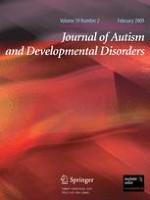01-02-2009 | Erratum
Autism Symptoms in Attention-Deficit/Hyperactivity Disorder: A Familial Trait which Correlates with Conduct, Oppositional Defiant, Language and Motor Disorders
Gepubliceerd in: Journal of Autism and Developmental Disorders | Uitgave 2/2009
Log in om toegang te krijgenExcerpt
The following is a corrected version of Table 4:
Table 4
Cluster analysis: SCQ responses for ADHD probands
|
Size of the clusters
|
ADI
|
Cluster 1
31%
|
Cluster 2
22.5%
|
Cluster 3
21%
|
Cluster 4
18.5%
|
Cluster 5
7%
|
|---|---|---|---|---|---|---|
|
Conversations
|
C
|
−−−−
|
−−−−
|
−−−−
|
−−−−
|
−−
|
|
Stereotyped utterances
|
C
|
−−−−
|
++
|
−−−
|
−−−
|
+++
|
|
Inappropriate questions
|
C
|
−−
|
+++
|
−−
|
−
|
++++
|
|
Pronoun reversal
|
C
|
−−−−
|
−−−
|
−−−−
|
−−−−
|
+
|
|
Neologisms
|
C
|
−−−−
|
+
|
−−−−
|
−−−−
|
++
|
|
Verbal rituals
|
R
|
−−−−
|
−
|
−−−−
|
−−−−
|
+++
|
|
Compulsions and rituals
|
R
|
−−−−
|
−
|
−−−−
|
−−−
|
+++
|
|
Inapprop. facial expression
|
S
|
−−−−
|
−−−−
|
−−−−
|
−−−
|
−−
|
|
Use of other’s body to commun.
|
S
|
−−−−
|
−−−
|
−−−−
|
−−−−
|
−
|
|
Unusual preoccupations
|
R
|
−−−−
|
−−−
|
−−−−
|
−−−−
|
−
|
|
Repetitive use of objects
|
R
|
−−−−
|
+
|
−−−−
|
−−−
|
++++
|
|
Circumscribed interests
|
R
|
−−−−
|
+
|
−−−−
|
−−−
|
++
|
|
Unusual sensory interests
|
R
|
−−−−
|
−−
|
−−−−
|
−−−−
|
–
|
|
Hand and finger mannerisms
|
R
|
−−−−
|
−−
|
−−−−
|
−−−−
|
−−
|
|
Complex body mannerisms
|
R
|
−−−−
|
−
|
−−−−
|
−−−−
|
+++
|
|
Self injury
|
–
|
−−−−
|
−−
|
−−−−
|
−−−
|
+
|
|
Unusual attachment to objects
|
R
|
−−−−
|
−−−−
|
−−−−
|
−−−−
|
−−
|
|
Friends
|
S
|
−−−
|
−−−
|
−−
|
−
|
+
|
|
4–5 social chat
|
C
|
−−−−
|
−−−
|
−
|
+
|
+
|
|
4–5 imitation
|
C
|
−−−−
|
−−−−
|
−−
|
+
|
−
|
|
4–5 point to express interest
|
C
|
−−−−
|
−−−−
|
−−−
|
−−
|
−−−
|
|
4–5 gestures
|
C
|
−−−−
|
−−
|
++++
|
++
|
+
|
|
4–5 nod yes
|
C
|
−−−−
|
−−−−
|
−−
|
−−
|
−−−−
|
|
4–5 shake head no
|
C
|
−−−−
|
−−−−
|
−−
|
−−
|
−−−−
|
|
4–5 eye gaze
|
S
|
−−−−
|
−−
|
−−−
|
+
|
++++
|
|
4–5 social smile
|
S
|
−−−−
|
−−−−
|
−−−−
|
−−
|
+
|
|
4–5 showing and directing attention
|
S
|
−−−−
|
−−−−
|
−−−−
|
−−−−
|
−−−
|
|
4–5 offer to share
|
S
|
−−−−
|
−−−−
|
−−−−
|
−
|
++
|
|
4–5 shared enjoyment
|
S
|
−−−−
|
−−−−
|
−−−−
|
−−−
|
−
|
|
4–5 offer comfort
|
S
|
−−−−
|
−−−−
|
−−−−
|
−−
|
−−
|
|
4–5 quality of social overtures
|
S
|
−−−−
|
−−−−
|
−−
|
−−−
|
−−−
|
|
4–5 range facial expression
|
S
|
−−−−
|
−−−−
|
−−−−
|
−−−−
|
−−−
|
|
4–5 imitative social play
|
C
|
−−−−
|
−−−−
|
−−−−
|
+++
|
++
|
|
4–5 imaginative play
|
C
|
−−−−
|
−−−−
|
−−−−
|
+
|
+
|
|
4–5 interested other children
|
S
|
−−−−
|
−−−−
|
−−−−
|
++
|
+++
|
|
4–5 respond to other children
|
S
|
−−−−
|
−−−−
|
−−−−
|
−
|
++
|
|
4–5 attention to voice
|
−
|
−−−−
|
−−
|
−−−−
|
+
|
++++
|
|
4–5 imaginative play peers
|
S
|
−−−−
|
−−−
|
−−−
|
+++
|
++++
|
|
4–5 group play
|
S
|
−−−−
|
−−
|
−−−−
|
+++
|
+++
|
